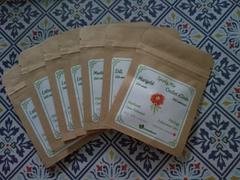The exact date of origin of Little Gem lettuce is hard to establish, but it is certainly an old heirloom, most likely from Britain. Little Gem is a cross between small specimens of romaine and butterhead type. The overall appearance of Little Gem leans more toward romaine, growing to about half the size of regular lettuce. The heads grow to only about 6 inches by 6 inches with a thick heart that fits in the palm of your hand, making it a nice personal size lettuce.
Little Gem lettuce is heat tolerant and somewhat resistant to common pests. An ideal candidate for successive sowings from spring until fall, this variety is well adapted to small spaces and intensive planting. Little Gem lettuce is very easy and convenient to grow in beds, containers or large window boxes.
One of the best-tasting lettuces you’ll find, it is great in sandwiches and makes for a nice individual mini-sized Caesar salad with a wholesome appearance. Little Gem is becoming increasingly popular at farmer’s markets for their cute looks, ultra-crispness and sweet, never bitter flavour. This old reliable heirloom has become so popular, in fact, that it has recently become mainstream and is sold at some Whole Foods and Costco supermarkets.
GROWING INSTRUCTIONS
Lettuce is the cornerstone of many great salads. And with so many varieties to choose from, why not grow your own and make a custom greens mix?
Lettuce seeds can be directly sown as soon as the garden can be worked and the soil reaches at least 4°C. Seeds will germinate best between 13 and 18°C. If you want to get a head start, seeds may be started indoors 4-6 weeks before the last spring frost. Plant in flats 1 cm deep, every 3 cm. Thin seedlings to 25 cm apart when they have 3-4 true leaves.
Lettuce likes sunny spots, but will tolerate some shade, especially in the hot summer months. Make sure the soil is loose and well drained. If sowing directly, pay extra attention to the consistency of the soil. Because of the seed’s small size, the bed should be well tilled and free of any debris. Transplant when seedlings have 4-6 true leaves and a well-established root system. Water thoroughly after transplanting.
Spacing in the garden is dependent on the type and variety of lettuce. If leaves become wilted, you can be sure that water is needed. Sprinkle the leaves with water anytime of day and keep the soil evenly moist. If needed, use row covers or shade cloth to shelter from the sun and prevent drying out. You can also map out the garden so that the lettuce will be shaded by some taller crops.
Mulch around the plants to keep the shallow roots cool and moist. If weeds do emerge among the lettuce, promptly and carefully remove them. Don’t let heads surpass their readiness date, leaves will become tough and bitter. Refer to the specific instructions for your variety.
Loose leaf, butterhead and romaine types can be harvested by collecting the outer leaves and allowing the centre to continue growing. Crisp head lettuces should be cut whole when the heads are full and dense. The morning is the best time to harvest, leaves will be crisp and fresh.
QUICK FACTS
- Lettuce was first cultivated in ancient Egypt for the production of oil from its seeds. This plant was then selectively bred by the Egyptians for its edible leaves as early as 3,000 BC. The domestication of lettuce over the millenniums has resulted in several changes: delayed bolting, larger seeds, larger leaves and heads, better taste and texture, and different leaf shapes and colours.
- Lettuce is a cool-weather crop so it needs partial shade during the hot summer months or the leaves need to be misted on hot days.
- Allow enough space between the seeds to grow as overcrowding can cause lettuce to turn bitter.
- There are four main types of lettuces: crisphead, butterhead, romaine and loose-leaf.
- Lettuce seeds will remain viable for 4 years if stored in a cool, dark place, ideally between 4 and 10⁰C. After that, the germination rate may start to go down.
OUR SEED GUARANTEE
You know that a lush, fruitful garden needs good soil, frequent watering, and sunlight to grow, but it’s the seeds that really make the harvest.
Picked and bagged for 2026 the vast majority of our seeds have germination rates of over 85%. The seeds are all-natural, non-GMO, non-hybrid, untreated, and open-pollinated for seed saving.
We have put a lot of thoughts into the design and packaging of our seed packets. Our seeds are all carefully packed in food grade kraft paper/aluminium zipper lock bags, and then are shipped in eco-friendly padded mailers.
We heat-seal each of our seed packet for even more protection from moisture, odour and light, allowing you to store your seeds for up to 3x longer than paper or plastic. Plant them all, germinate some indoors, save some for next season - it’s up to you!





![[Premium Quality Ethical & Sustainable Seeds]-Ecoseedbank](http://ecoseedbank.com/cdn/shop/products/lettucelittlegem_{width}x.jpg?v=1643373694)

